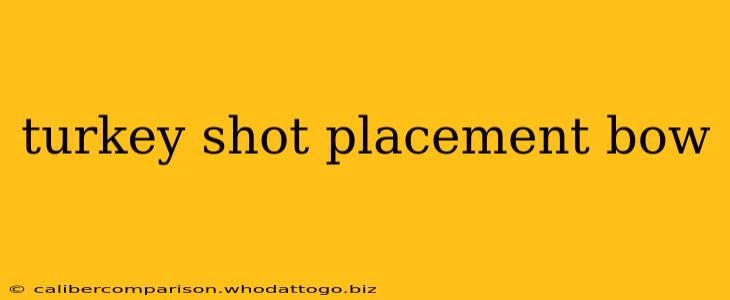Bow hunting turkeys presents unique challenges, demanding precision and a thorough understanding of turkey anatomy. A well-placed shot is crucial for a quick, ethical harvest, minimizing suffering and ensuring a successful hunt. This guide delves into the vital areas for accurate shot placement when bow hunting turkeys.
Understanding Turkey Anatomy for Accurate Shots
Before discussing shot placement, let's examine a turkey's vital organs. The heart and lungs are the primary targets, located within the breast area. However, the precise location and size of these organs vary slightly depending on the bird's size and posture.
Key Areas to Aim For:
-
The "Kill Zone": This area, roughly the size of a softball, encompasses the heart and lungs. It's situated just behind the turkey's breastbone, slightly below the wing's point of attachment. Aiming for this zone significantly increases your chances of a clean, one-shot kill.
-
The Head and Neck (Less Ideal): While a shot to the head or neck can be lethal, it's considerably less reliable. The small target area and the potential for a deflected shot make this a risky option. A poorly placed shot to the head might only wound the bird, leading to a lengthy and inhumane chase.
-
Avoid the Wings and Legs: Shots to the wings and legs are unlikely to produce a quick kill and are generally considered unethical. These areas lack vital organs, and a wounded bird could escape, suffer needlessly, or become a target for scavengers.
Factors Influencing Shot Placement
Several factors can influence your shot placement, demanding careful consideration and adaptability:
1. Turkey Posture:
A turkey's posture significantly impacts the location of its vital organs. A bird standing upright presents a different target than one that is strutting or feeding. Understanding this variability is key to successful shot placement.
2. Shot Distance:
Accurate shot placement becomes increasingly challenging with distance. Bow hunting turkeys typically involves shots at shorter ranges (under 30 yards), where accuracy is maximized. Beyond this range, the margin for error shrinks dramatically.
3. Broadhead Selection:
The type of broadhead used also plays a role. A well-designed, sharp broadhead maximizes penetration and increases the likelihood of reaching the vital organs. Consider using broadheads specifically designed for turkey hunting, as they're often built for improved accuracy and penetration at close range.
Practice Makes Perfect: Refining Your Shot
Consistent practice is essential for successful turkey bow hunting. Practice shooting at targets that simulate the size and shape of a turkey at various distances and postures. This will help refine your aim and improve your shot placement accuracy.
Ethical Considerations
Always prioritize ethical hunting practices. A clean, quick kill minimizes suffering. If you're not confident in your ability to make an accurate shot, it's better to pass up the opportunity. Remember, responsible hunting is paramount.
Conclusion
Successful turkey bow hunting relies heavily on precise shot placement. By focusing on the "kill zone" and considering the factors discussed above, you can significantly improve your chances of a successful and ethical harvest. Remember practice and ethical considerations are key to a successful and responsible hunt.

